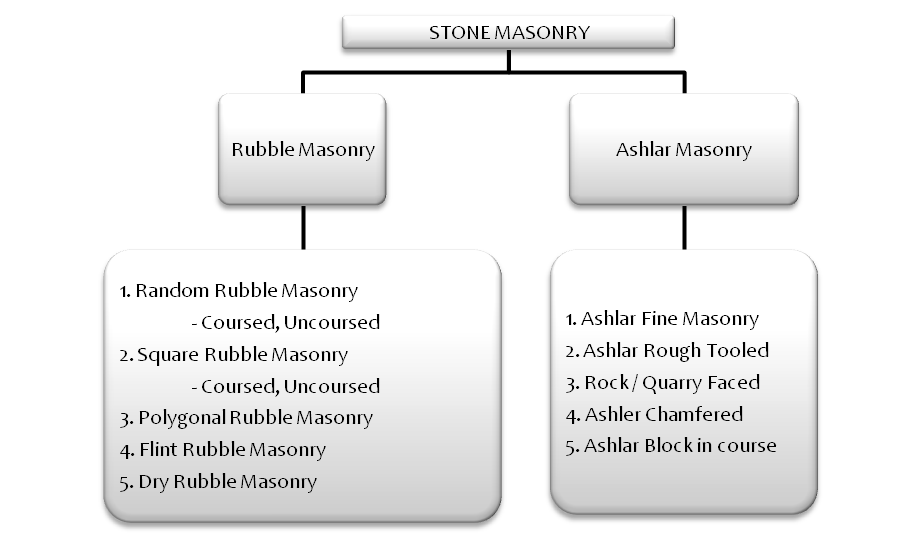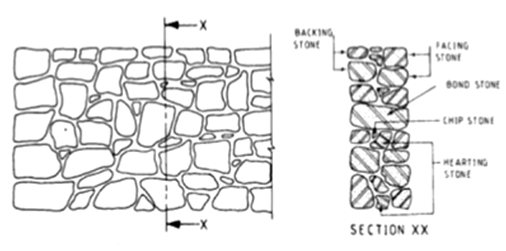Based on the arrangement of stone in the construction and degree of refinement in the surface finish, stone masonry can be classified broadly into the following two categories

Masonry where stones are either undressed or roughly dressed having wider joints is known as Rubble Masonry. They can be further subdivided into uncoursed, regular, random, dry, polygonal and bint.


Random Rubble Masonry – Coursed Flint Rubble Masonry
Masonry work is carried out in courses such that that the Stones used are flints or cobble. Stones are irregularly shaped nodules of
stones in a particular course is of equal height. silica and extremely hard but brittle.


Dry Rubble Masonry
Larger pieces of stones are tightly packed with smaller pieces and no mortar is used for joints. Mostly used in the construction of retaining walls, canal slopes etc.
Ashlar Masonry is built from accurately dressed stones with uniform and fine joints of 3mm thickness by arranging the stone blocks in various patterns. The cost of Ashlar Masonry walls are expensive and needs higher construction skills.
Ashlar Block in Course Masonry
A combination of ashlar and rubble masonry, the face work is provided by rough tooled or hammer dressed stones and the backing of the wall is constructed by rubble masonry.
BIBLIOGRAPHY
- Ashurst, J. Cleaning stone and brick. (Technical Pamphlet N°4). London: Society for the Protection of Ancient Buildings, 1977.
- ICCROM, Scientific Principles of Conservation Course. Course exercises, 1977.
- Mora, P. and Mora-Sbordoni, L. Metodo per la rimozione di incrostazione su pietre calcaree edipinti murali. In: Problemi di Conservazione, Bologna: Editrice Compositori, 1975, pp. 339-344.
- ICCROM, ARC laboratory manual for Architectural Conservators, Jeanne Marie Teutonico, Rome,1988
PUBLICATIONS
1. Stone Conservation: An Overview of Current Research, The Getty Conservation Institute.
http://www.getty.edu/conservation/publications_resources/pdf_publications/pdf/stoneconservation.pdf
2. Illustrated Glossary On Stone Deterioration Patterns, ICOMOS International Scientific Committee for Stone (ISCS).
3. Structural Conservation of Stone Masonry, International Technical Conference Athens, 31.X. — 3.XI.1989 ICCROM.
https://www.iccrom.org/sites/default/files/2018-02/1990_stone_masonry_athens_49219_light.pdf
4. Historic Stone Masonry Restoration, Journal of architectural technology published by Hoffmann Architects, Inc.
https://www.brikbase.org/sites/default/files/Vol-31-N2-Historic-Stone-Masonry.pdf

